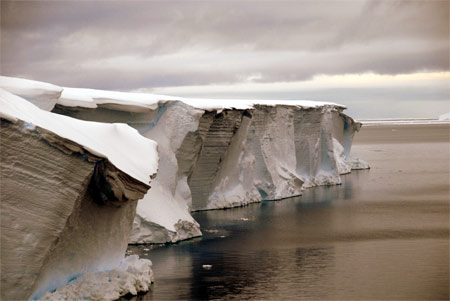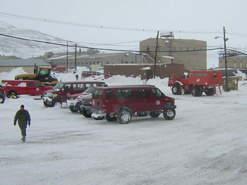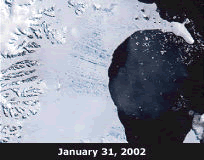A view of the Larson B Ice Shelf (Antarctica) breaking apart in 2002, compiled using MODIS images
Courtesy of the National Snow and Ice Data Center
Warming on the Antarctic Peninsula
Antarctica is a cold place. If you were to go visit, you would need a thick winter coat, hat, and mittens. However, along the coast, in an area called the Antarctic Peninsula, it has been getting much warmer. Global warming is causing the planet as a whole to warm, but some areas get warmer faster than others. The Antarctic Peninsula is one of these fast-warming places.
Warmer temperatures are causing giant ice shelves to collapse into the Southern Ocean. This animation that is at the left shows what it looked like when one of these ice shelves broke apart.
The Southern Ocean is also warming. This affects the animals that live there. There is fewer plankton in the Southern Ocean and less winter sea ice for penguins. Many Adelie penguins have moved south to areas that are colder. (To take a look at an abandoned penguin colony, click here.)
Unlike the Antarctic Peninsula, temperatures in the middle of the Antarctica are not getting much warmer right now. However,
climate models tell us that
Antarctica will become warmer in the future.
Last modified February 23, 2007 by Lisa Gardiner.
You might also be interested in:

Antarctica is the coldest, windiest, and driest continent on Earth. It is about one and a half times the size of the United States. Almost all of Antarctica is covered with a thick layer of ice called
...more
The Southern Ocean is sometimes known as the Antarctic Ocean or South Polar Ocean. It surrounds Antarctica in the South Polar Region. The Southern Ocean is a bit different from other oceans. Other oceans
...more
To figure out what the Earth might be like in the future, scientists need to know how Earth reacts to changes. Models help scientists to better understand how the Earth works and how it will react to climate
...more
The Antarctic Peninsula is warming faster than most other places in the world. Warmer temperatures mean that there is now less sea ice in the nearby Southern Ocean. Plus winds are changing too. Scientists
...more
Looking for online content that can be used for a climate change education course or module? Pages linked below can be used to support an introductory climate change education for either a unit or a full
...more
Polar exploration includes the exploration of the Arctic and the Antarctic. The Arctic is the area around the Earth's north pole. Antarctica is a continent that surrounds the South Pole. When you think
...more
What Will You Find There? If you travel to the South Pole, you will find the continent of Antarctica surrounded by the Southern Ocean. The geographic South Pole is marked by a large sign that scientists
...more














